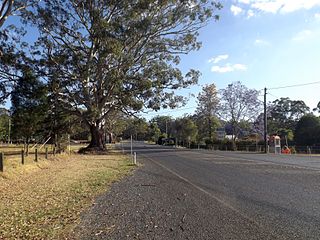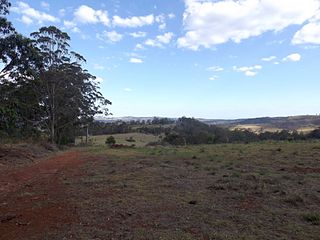
Esk is a rural town and locality in the Somerset Region in South East Queensland, Australia. In the 2021 census, the locality of Esk had a population of 1,641 people.

Crows Nest is a rural town and locality in the Toowoomba Region, Queensland, Australia. The town is located in the Darling Downs on the New England Highway, 158 kilometres (98 mi) from the state capital, Brisbane and 43 kilometres (27 mi) from the nearby city of Toowoomba. In the 2021 census, the locality of Crows Nest had a population of 2,212 people.

Hampton is a rural town and locality in the Toowoomba Region, Queensland, Australia. In the 2021 census, the locality of Hampton had a population of 469 people.

The Esk–Hampton Road is a state highway in Queensland. It leaves the Brisbane Valley Highway at Esk and travels in a westerly direction for 45.7 km (28 mi) until it reaches the New England Highway at Hampton, where it ends. This road is part of State Route 85, which extends for over 570 km (354 mi) from Bribie Island to Nindigully, duplexing with the Brisbane Valley Highway from the D'Aguilar Highway to Esk, the New England Highway from Hampton to Toowoomba, the Gore Highway from Toowoomba to the Leichhardt Highway, and the southern 19 km (12 mi) section of the Leichhardt Highway to Goondiwindi.
Crows Nest Branch Railway was originally surveyed as a direct line from Toowoomba north to Crows Nest in Queensland, Australia. The branch eventually took a more circuitous route to cover the maximum amount of farming country. The first stage struck out from Pengarry Junction a short distance west of Toowoomba and continued via Birnan, Cawdor, Shirley, Woolmer, Meringandan and Kleinton to terminate at Cabarlah. It opened on 17 September 1883. Shortly after opening, a daily service was provided to Cabarlah.

Pechey is a rural locality in the Toowoomba Region, Queensland, Australia. In the 2021 census, the locality of Pechey had a population of 98 people.

The Shire of Highfields is a former local government area on the Darling Downs in Queensland, Australia. It existed between 1879 and 1949.

Perseverance is a rural locality in the Toowoomba Region, Queensland, Australia. In the 2021 census, Perseverance had a population of 72 people.

Grapetree is a rural locality in the Toowoomba Region, Queensland, Australia. In the 2021 census, Grapetree had a population of 42 people.
Buaraba is a rural locality in the Somerset Region, Queensland, Australia. In the 2021 census, Buaraba had a population of 170 people.
Murrumba is a rural locality in the Somerset Region, Queensland, Australia. In the 2021 census, Murrumba had "no people or a very low population".

Palmtree is a rural locality in the Toowoomba Region, Queensland, Australia. In the 2021 census, Palmtree had a population of 80 people.
Pierces Creek is a rural locality in the Toowoomba Region, Queensland, Australia. It was formerly known as Virginia. In the 2021 census, Pierces Creek had a population of 95 people.
Pinelands is a rural locality in the Toowoomba Region, Queensland, Australia. In the 2021 census, Pinelands had a population of 81 people.
Caboonbah is a rural locality in the Somerset Region, Queensland, Australia. In the 2021 census, Caboonbah had a population of 13 people.

Biarra is a rural locality in the Somerset Region, Queensland, Australia. In the 2021 census, Biarra had a population of 270 people.
Scrub Creek is a rural locality in the Somerset Region, Queensland, Australia. In the 2021 census, Scrub Creek had a population of 33 people.
Eskdale is a rural locality in the Somerset Region, Queensland, Australia. In the 2021 census, Eskdale had a population of 34 people.
Emu Creek is a rural locality in the Toowoomba Region, Queensland, Australia. In the 2021 census, Emu Creek had a population of 113 people.
Merritts Creek is a rural locality in the Toowoomba Region, Queensland, Australia. In the 2021 census, Merritts Creek had a population of 102 people.












